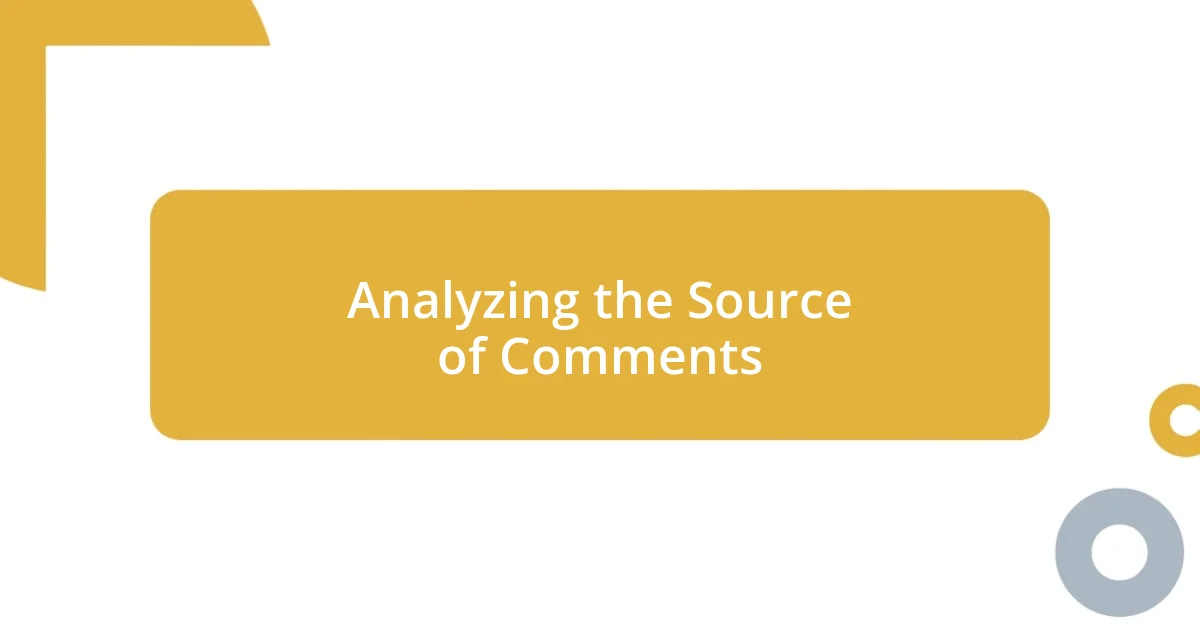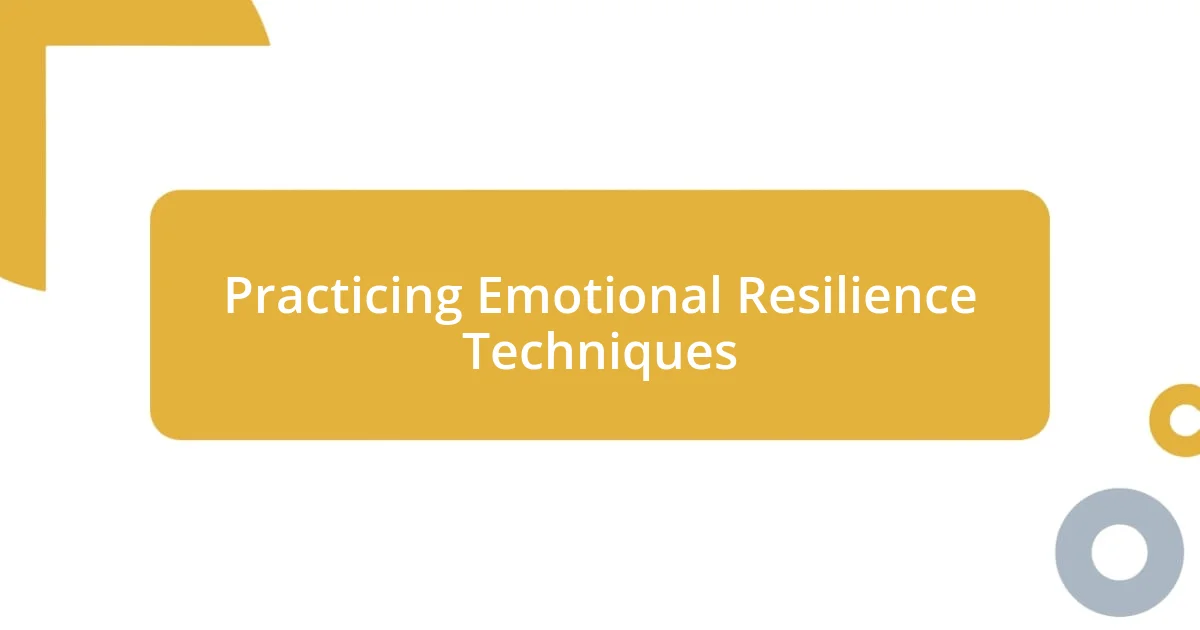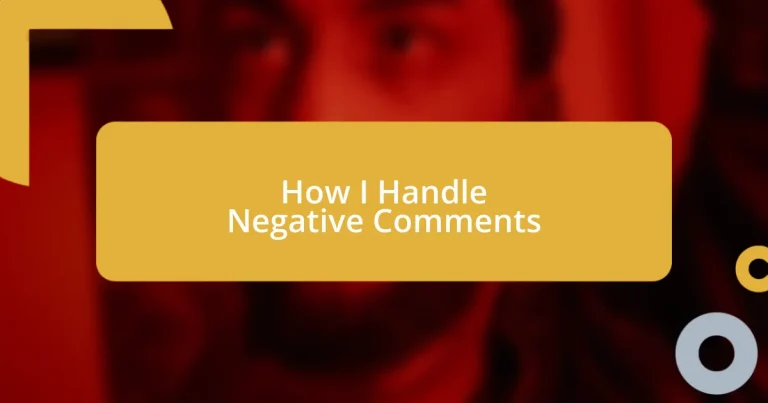Key takeaways:
- Recognizing that negative comments often reflect the commenter’s insecurities can help in understanding and processing the feedback.
- Developing a response strategy, including planning phrases and maintaining empathy, can transform negative interactions into constructive conversations.
- Embracing constructive criticism through reflection and journaling fosters personal growth and enhances professional skills.

Understanding Negative Comments
Negative comments can feel like a punch to the gut, can’t they? I remember when I shared my first big project online. The praise was sweet, but the criticism stung more than I expected. It left me wondering why some people felt the need to tear down what others build up.
Understanding the nature of these comments is crucial. Often, negative feedback reflects more about the person making the comment than the work itself. Have you ever noticed how some comments come from individuals who seem to be grappling with their own insecurities? It’s almost like a defense mechanism for them—a way to project their frustrations onto someone else.
When I receive negative comments, I try to dissect them—are they constructive or just mean-spirited? There’s a difference, and recognizing it can change how I respond. For instance, a well-intentioned critique can offer valuable insights, while a nasty remark often reveals the commenter’s character. It’s a process of sorting through noise to find any gold nuggets that might actually help me grow.

Identifying Triggers for Negative Feedback
Identifying the triggers for negative feedback can be a valuable exercise. I’ve realized that certain topics I’m passionate about or projects close to my heart often provoke the strongest reactions. For example, when I shared my artistic interpretation of a sensitive subject, the backlash was intense. I suspect that my enthusiasm might have triggered discomfort for some people, making them feel compelled to voice their negativity.
Another aspect I focus on is the context in which feedback occurs. In one instance, I revealed a personal story on social media during a time of high social tension. This undoubtedly stirred up emotions, resulting in harsh comments. It made me aware that negativity often spikes in high-stress environments. By tuning into the surrounding atmosphere, I can better understand why certain comments land the way they do.
Ultimately, I keep a mental note of my emotional responses. I’ve noticed that I’m more sensitive to criticism after a long day or when I’m feeling vulnerable. When I reflect on this, it helps me recognize that my mood can amplify how I perceive negative feedback and helps me navigate these encounters with more clarity.
| Trigger Type | Example |
|---|---|
| Personal Investment | Sharing a project personal to me evokes strong reactions. |
| Contextual Factors | Timing of feedback during social turmoil can intensify negativity. |
| Emotional State | Feeling vulnerable can heighten sensitivity to criticism. |

Analyzing the Source of Comments
When I engage with negative comments, I often find it enlightening to consider the source. Is the comment coming from someone I respect, or a random user hiding behind a screen? For instance, I once received a harsh critique on a blog post from a self-proclaimed expert in my field. Initially, my heart sank, but upon further inspection, their profile showed a lack of substantial achievements. This insight shifted my focus from their words to understanding their intention.
Here are a few elements I keep in mind when analyzing the source of comments:
- Credibility: Is the commenter qualified to provide feedback on the topic?
- Anonymity: Does the commenter use a pseudonym or profile without real identity? This often suggests they’re less invested.
- Past Interactions: Have previous comments from this person been thoughtful or merely negative? Their history can reveal patterns.
By reflecting on these points, I aim to foster a more nuanced view of negativity. It’s like putting on a new pair of glasses; I start to see that many criticisms stem from the commenter’s personal experiences rather than any failing on my part.

Developing a Response Strategy
Developing a response strategy for negative comments requires a thoughtful approach. I often start by identifying what kind of response is most appropriate for the situation. One time, I received a comment about my writing that felt particularly harsh. Instead of retaliating, I paused and asked myself: “What can I learn from this?” This simple question shifted my focus toward constructive engagement rather than defensiveness.
Next, I think about the emotional tone I want to convey. For example, during a heated exchange online, I once chose to respond with empathy, acknowledging the commenter’s feelings. It turned out to be an effective approach, as it not only diffused the negativity but also led to a more constructive conversation. By being intentional about my tone, I ensure that my responses invite a dialogue rather than further hostility.
Finally, I find it helpful to plan my responses in advance. I keep a few phrases in my back pocket that reflect my values, like “I appreciate your perspective” or “Let’s discuss this further.” During a particularly challenging time, having those phrases ready helped me remain composed when negativity struck. How powerful is it to have a few go-to responses? I can’t stress enough how much this preparation eases the emotional weight of facing criticism head-on.

Practicing Emotional Resilience Techniques
Practicing emotional resilience techniques is something I’ve found incredibly useful in handling negativity. One method is grounding, which involves emphasizing your physical presence when feeling overwhelmed. I remember a time when I faced a barrage of negative comments on social media. In that moment, I took a deep breath, felt my feet on the floor, and focused on the sensation of my breath moving in and out. That simple act helped me regain control, reminding me that I am more than the opinions of others.
Another technique I regularly utilize is reframing. This means viewing the negative feedback through a different lens. For example, when I received a particularly biting critique about my podcast, instead of viewing it as a personal attack, I considered it constructive feedback. My thought process shifted from “They don’t like me” to “What can I improve?” This mindset change opens up opportunities for growth and self-improvement while blooming my emotional resilience to criticism.
I also believe in the power of self-compassion. There are days when the sting of negativity feels particularly sharp, leading me to ask, “Why am I allowing someone else’s words to impact me so deeply?” Reassuring myself that it’s okay to feel hurt, yet reminding myself that my worth isn’t determined by external opinions, creates a safe space for my emotions. This balance seems vital; I can grow from criticism without letting it define who I am. How often do we overlook the importance of kindness towards ourselves in the face of negativity? It’s a game changer.

Learning from Constructive Criticism
When I receive constructive criticism, I make it a habit to pause and reflect on the feedback. I vividly remember a time when an editor pointed out that my article’s introduction lacked clarity. Initially, it stung, but as I revisited the piece, I realized they were right. Asking myself, “How can I clarify my message?” led to a much stronger opening. It’s amazing how a shift in perspective can turn an initial reaction of defensiveness into an opportunity for improvement.
I also keep a personal journal where I document my reactions to feedback. There was an instance where a mentor critiqued my presentation skills, and I felt disheartened at first. However, writing about it helped me identify specific areas where I could grow. In my journal, I noted, “What did I do well? What can I change?” This reflective practice turned a negative experience into a roadmap for my development, reinforcing the idea that constructive criticism can be a guiding light rather than a roadblock.
Embracing constructive feedback has played a pivotal role in my professional journey. One time, I attended a workshop where participants exchanged feedback about their projects. Initially, my anxiety surged at the thought of sharing my work, fearing judgment. However, witnessing others’ openness shifted my mindset. I took the plunge and came away with actionable insights that turned my project into something I was proud to showcase. Isn’t it fascinating how vulnerability can lead to moments of profound growth and connection?

Moving Forward After Handling Comments
Moving forward after handling negative comments requires a conscious choice to embrace growth. I remember one particular comment that stung—a sarcastic remark about a presentation I believed went well. Instead of dwelling on it, I decided to channel my frustration into preparation for my next talk. Reflecting on that experience, I realized that those negative comments could actually serve as motivators for excellence rather than roadblocks.
In a recent workshop, someone critiqued my approach to a project I was passionate about. At first, I resisted the urge to defend myself. But after the session, I took a step back and asked, “What did I learn from this?” That simple question unveiled new ideas I hadn’t considered before. It’s empowering to transform critiques into stepping stones, don’t you think? By letting go of defensiveness, I opened myself up to a wellspring of creativity.
I often remind myself that not every negative comment reflects the truth of my capabilities. There have been days when I felt like quitting after reading a harsh review, yet something inside me nudged me to push through. I found that the journey of moving forward was not just about improvement—it’s also about resilience and the joy of proving to myself that I can thrive despite adversity. Isn’t that what personal growth is all about? Embracing the discomfort and emerging stronger on the other side.














